The New Louis Vuitton Tambour Watch (Video & Live Photos)
LV's most emblematic watch is back after a drastic makeover and enters the competitive luxury sports watch market with style!
The world’s most valuable luxury brand, Louis Vuitton, is intimately associated with leather goods and fashion. However, the French powerhouse is looking at luxury in all categories and, since 2002, has accumulated impressive watchmaking expertise. In 2002, Louis Vuitton premiered the Tambour watch, a model immediately recognisable thanks to its drum-shaped case (tambour in French). After two decades of loyal service, it is time for the Tambour to reinvent itself and write a new chapter. Now under the direction of Jean Arnault, Louis Vuitton watches and its manufacture La Fabrique du Temps, have conceived the new Louis Vuitton Tambour, which returns as a new contender in one of the most disputed categories, the luxury sports watch with integrated bracelet. And we’ll tell you all about it in our exclusive video with Jean Arnault posted above.
The Tambour – 2002-2022
The first Louis Vuitton Tambour appeared in 2002 as a traveller’s watch with a GMT function – which made sense given the brand’s historical ties to travel. Although it wasn’t LV’s first-ever watch, it marked the debut of its watchmaking strategy. Designed by BBDC – Berra Blanquer Design – this watch was most notable for its drum-shaped case and unusual flared profile, which was wider at the base than at the top, including a wide caseband, the perfect canvas to engrave the 12 letters in the name Louis Vuitton, aligned with the hour markers. The lugs were an external design element to keep this Tambour as close as possible to its original concept.

Multiple watches would be created in the Tambour collection, including what could be the most emblematic, a chronograph powered by Zenith’s famous El Primero high-frequency calibre. The acquisition of La Fabrique du Temps in 2011 allowed Vuitton to mark its commitment to creative high-end watchmaking and to release watches with complex movements – Spin Time, Twin Chrono, Flying Tourbillon or Minute Repeater. Last year, Jean Arnault, just appointed Director of Watches at LV, decided that it was time for a complete revamp of the collection, but before that created a last and farewell version of the Tambour as we have come to know it: the Tambour Twenty Limited Edition.

A complete change of strategy
As Jean Arnault explained in our video interview, the new Louis Vuitton Tambour is the result of a brand-new strategy. For many years, LV watches were divided into three categories: the connected watches, the core collection and the Haute Horlogerie collection, represented by automata and high-end movements.
Today, we’re specifically talking about the core collection. In the past, we’ve seen watches following the dictates and trends of the fashion division, which meant the need to follow short development processes. However, conceiving a watch takes time, and Jean Arnault has decided to change the whole process behind the creation of watches and reposition the watch division as a bona fide player. The first action has been to drastically reduce the number of watches available in the collection – most have been discontinued, except for the Tambour Street Diver models. The second step is what you’ll discover today: a brand new and ambitious Louis Vuitton Tambour.
The New Louis Vuitton Tambour
Sleek, modern, elegant and casual at the same time, but mostly, a genuine watch, far from the codes of fashion. The new chapter in the life of the Tambour takes the shape of a watch that follows the codes of traditional watchmaking and has been deliberately designed to compete in one of the most crowded categories, the sporty-chic integrated watch. As Jean Arnault comments, Vuitton isn’t the first brand, nor will it be the last in this segment. However, it means that LV elevates its watch collection with an unprecedented level of sophistication covering every aspect of the watch. Gone are the LV-branded, fashion-oriented models. The future of Vuitton watches is far more serious.
The 2023 Louis Vuitton Tambour is released for now as a two-watch collection, both made of stainless steel. The idea behind the watch is to offer a high-end, slim and discreet touch of luxury on a daily basis. But mainly, it gives the emblematic Tambour a fresher look while retaining the signature elements of this family. The round drum-shaped case with curved sides is still present, and so is the volume of the watch, as well as the 12 letters engraved around the bezel. Soft, curved and offering a very pleasant tactile feeling, the classic Tambour has been profoundly reshaped and redefined.
First, let’s talk about proportions; to be a serious contender in the integrated watch market, there are codes to respect. The diameter of the new Tambour is a reasonable 40mm, a feeling reinforced by the pure round case and the absence of traditional lugs (the bracelet is attached under the case). Not only is the diameter compact, but compared to a Royal Oak or a Nautilus, the overall surface of the watch is also smaller. The idea was, no doubt, to produce a unisex model, something that reflects our times. The thickness is another important factor, and while most previous Tambours were objectively on the thick side, this new one isn’t. At 8.3mm, it is thin – again, a feeling reinforced by the high-positioned inflection point on the caseband that virtually slims down the profile.
Now, while the proportions and the overall feeling are that of a sporty-chic watch, the new Louis Vuitton Tambour stands out in a crowd of predominantly angular watches. It is far softer and less masculine than a RO or an Overseas. In this respect, it doesn’t try to mimic existing icons and sticks to the design elements that have made Tambour recognisable. Many distinctive elements can be seen in this case, starting with the bezel. Ultra-thin, polished on top to enlarge the dial, the side displays the 12 Louis Vuitton letters far more discreetly than before. Executed in positive relief over a matte background, these letters are barely visible at a distance. The rest of the case is mostly brushed and thus remains on the discreet side.
Framed by sapphire crystals on both sides, the case of the new Tambour is very pleasant on the wrist. The combination of small-ish proportions with an absence of shaped edges gives it a soft touch to the skin. It can be worn by men and women without problems. The water-resistance is rated at 50m, classic for thin watches. Overall, there’s noticeable attention to detail and design in this watch, which has been conceived to be worn and enjoyed, not to be seen (the difference between luxury and fashion…).
The bracelet is an important element of a watch from this category, and the bracelet of the Tambour flows seamlessly with the case thanks to its lug-free construction. As such, it is one of the few, if not the only, genuinely round watch with an integrated bracelet. The bracelet has been designed with great care. The short links are connected by small rounded mid-links, offering great flexibility. Also, the bracelet’s shape (as explained in the video) has been patiently designed to bring the desired tapering effect. It is closed by a thin, concealed triple-folding clasp. Two notes regarding the bracelet (topics that I touched on with Mr Arnault); the absence of a micro-adjustment system, which, as he explained, makes the clasp thicker; and the absence of a quick-change device, which is deliberate to retain the full metal attire.
The dial of the new Louis Vuitton Tambour follows the same design manifesto. If you look closely, you’ll spot some design elements of older Tambour watches – the combination of baton markers and Arabic numerals for the hours – but then again, LV brings here a fresher, more refined look. However, compared to the tactile smooth exterior, the dial of the new Tambour is crisp and sharply delineated. It is available in two editions: dark blue, a classic of the category, and silver-grey, offering a tone-on-tone look.
Despite being simple from a certain distance, under closer inspection, the dial has impressive depth and reveals interesting details. Starting from the periphery, it features a split-level chapter ring, divided by a polished step, consisting of an outer ring for the minuterie and an inner ring for the hours, both with micro-sandblasted main surfaces. The dial markers are designed to complement each other in terms of spatial balance, with recessed 5-minute markers and hours applied in relief. Not only does it create a three-dimensional effect, but it also helps read the time. The markers are white gold, as well as the hands, and are filled with Super-LumiNova. The hands have a new, tapered, faceted, openworked shape and are slimmer than before.
The central part of the dial is vertically brushed, and depending on the ambient light, it almost feels like it has a different colour. It is home to a snailed small seconds and a simple Louis Vuitton Paris logo. A sort of easter egg can be found at 6 o’clock, the “FAB. EN SUISSE” mention, replacing the traditional Swiss Made, bringing cool vibes of the 1950s and 1960s. It also alludes to the origin of the watch and La Fabrique du Temps (LFT) in Geneva.
Under the sapphire caseback of the new Louis Vuitton Tambour is a proprietary movement. And LV is pretty clear about its origin (transparency isn’t always a forte of Swiss watchmaking). This calibre is a joint concept between movement maker Le Cercle des Horlogers and La Fabrique du Temps – LFT designed the movement, defined the look and decoration, and manufactured some parts. A 3-hand automatic movement wound by a micro-rotor, it also comes with a chronometer certification (-4/+6 seconds/day) by the Geneva Chronometric Observatory under the auspices of the TIMELAB Foundation. And interestingly, Louis Vuitton is the first watchmaking company to certify its timepieces through the Geneva Chronometric Observatory.
The calibre LFT023 is otherwise traditional, with a 4Hz frequency and a comfortable 50h power reserve once fully wound by the high-inertia 22k gold rotor. The design and decoration are modern and refined, with sharp bridges decorated with micro-sandblasted surfaces and large polished chamfers. The main plate is circular-grained, the barrel drum is shaped like a Monogram Flower and the micro-rotor is decorated with a stylised LV in a repeating motif. Finally, a nice touch, the jewels are colourless for a resolutely modern and sleek look.
Availability & Price
The new Louis Vuitton Tambour is now available with orders from LV boutiques exclusively. The first deliveries are expected in September 2023, and the watch is priced at EUR 19,500 (incl. taxes). For more details, please visit louisvuitton.com.

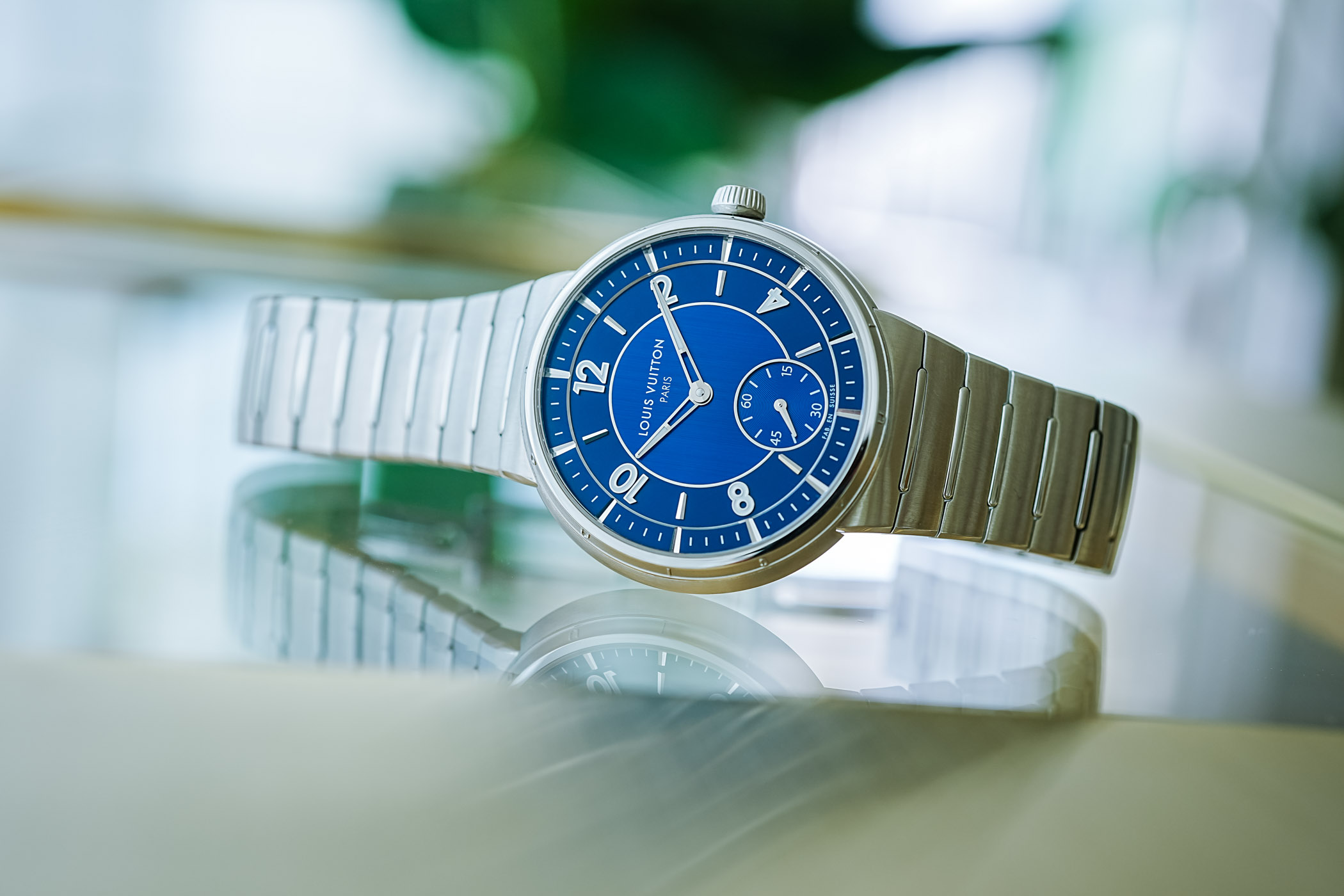
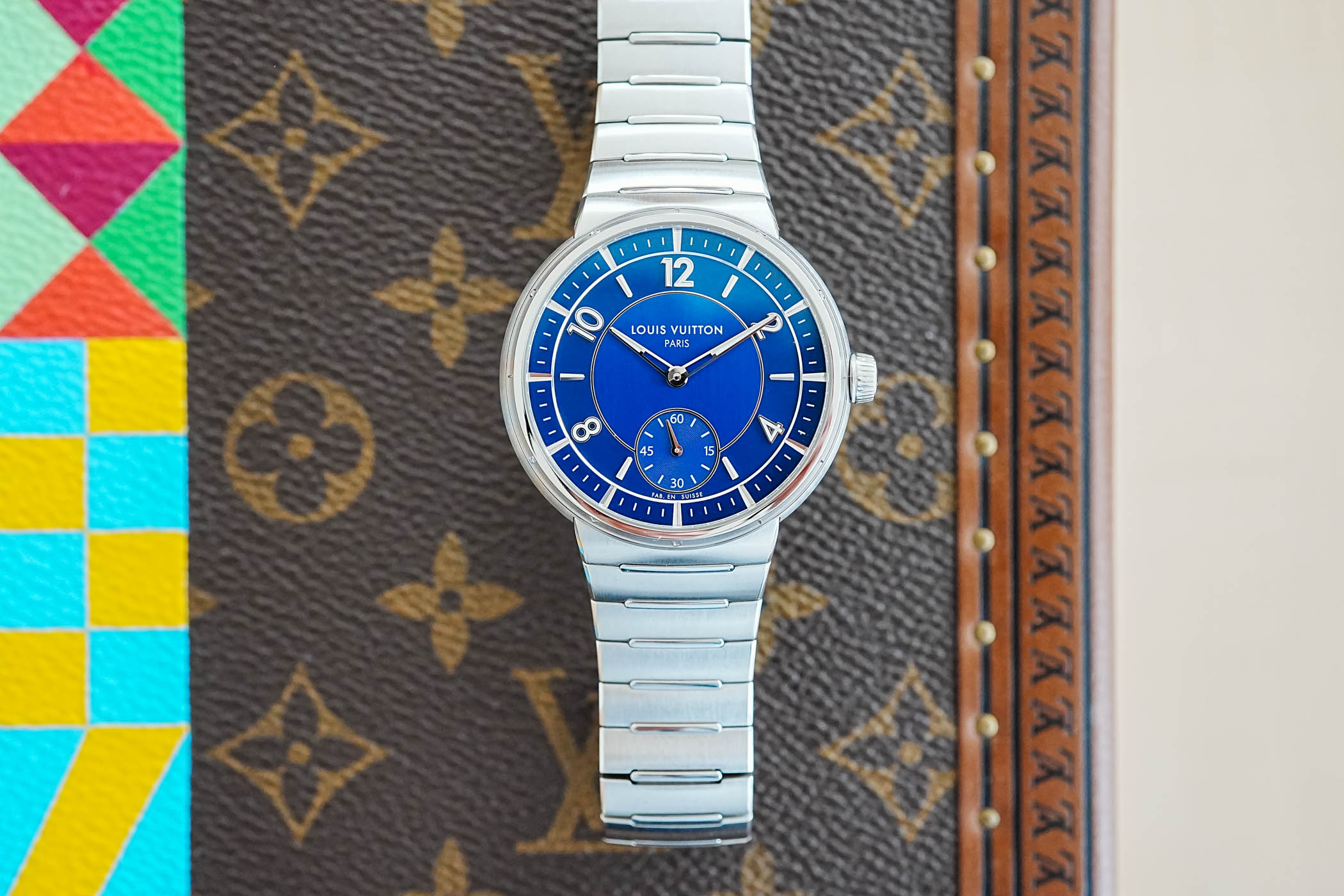



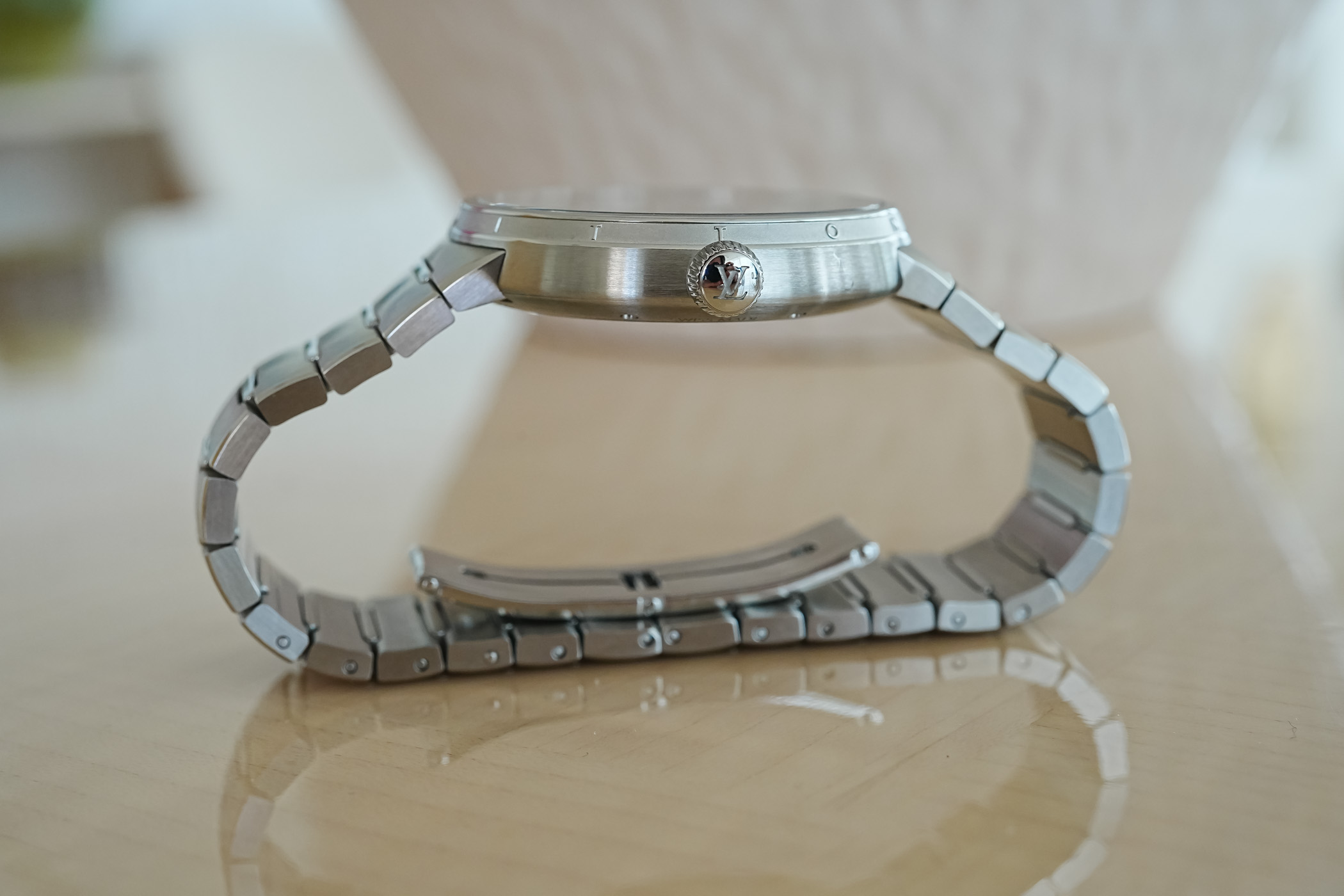
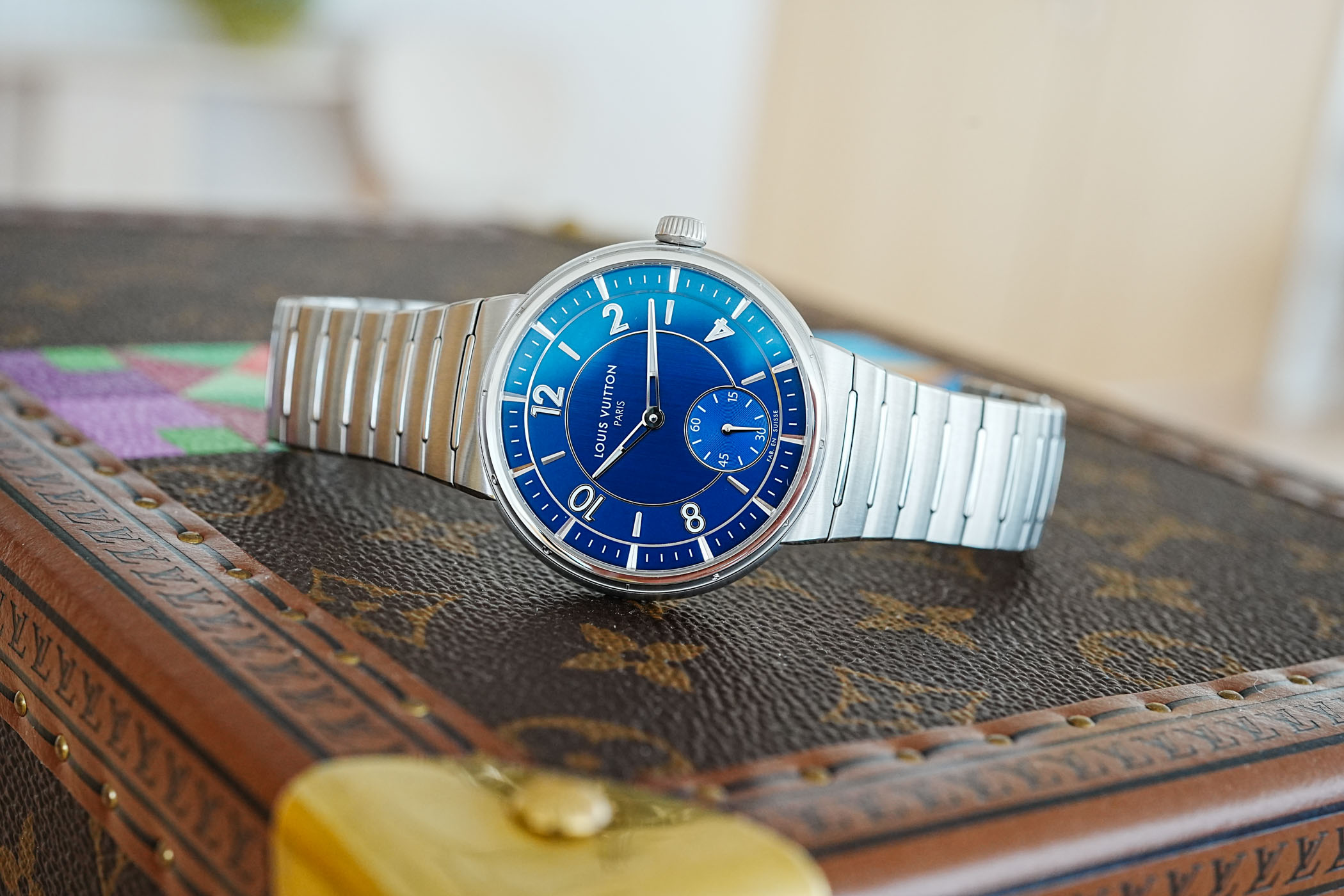

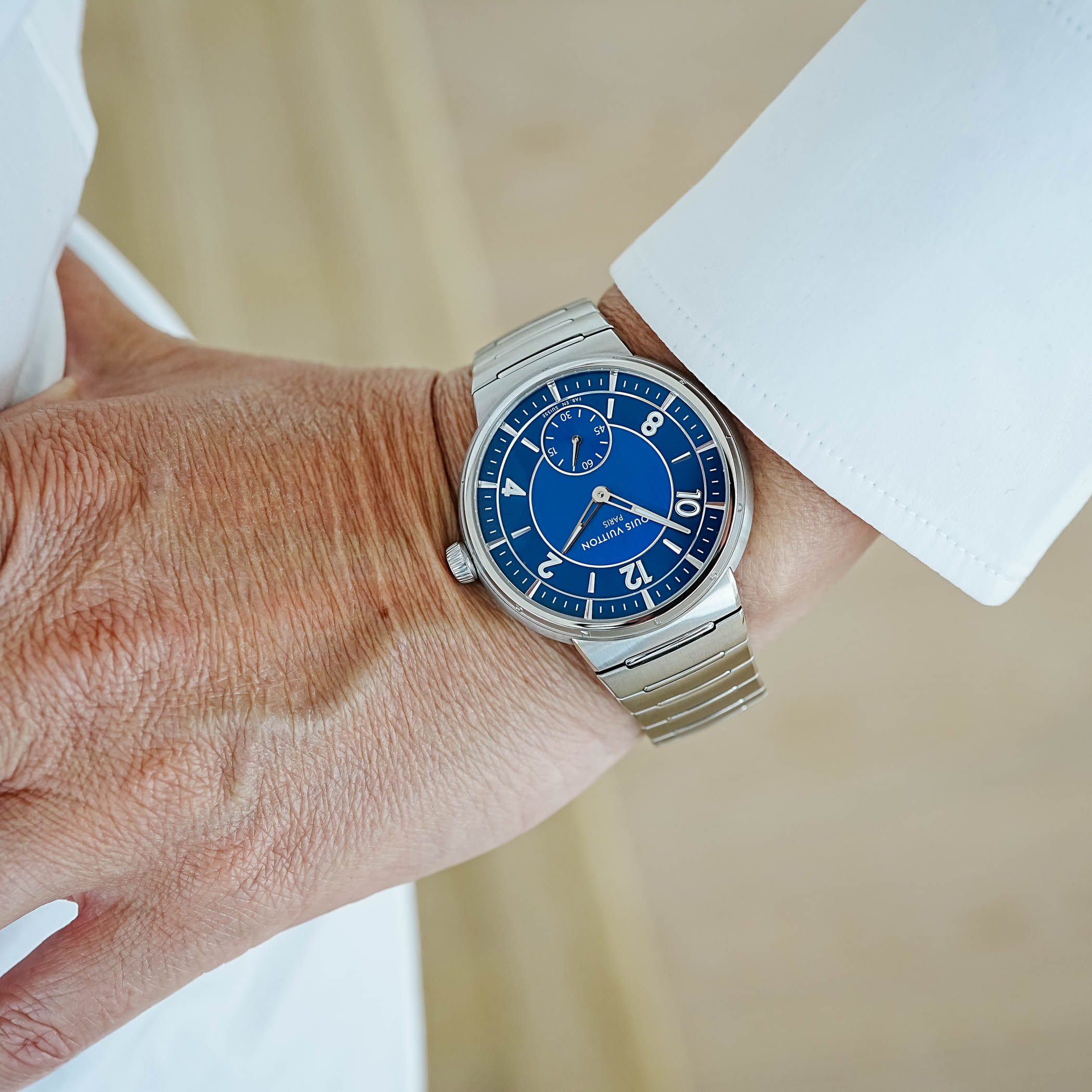
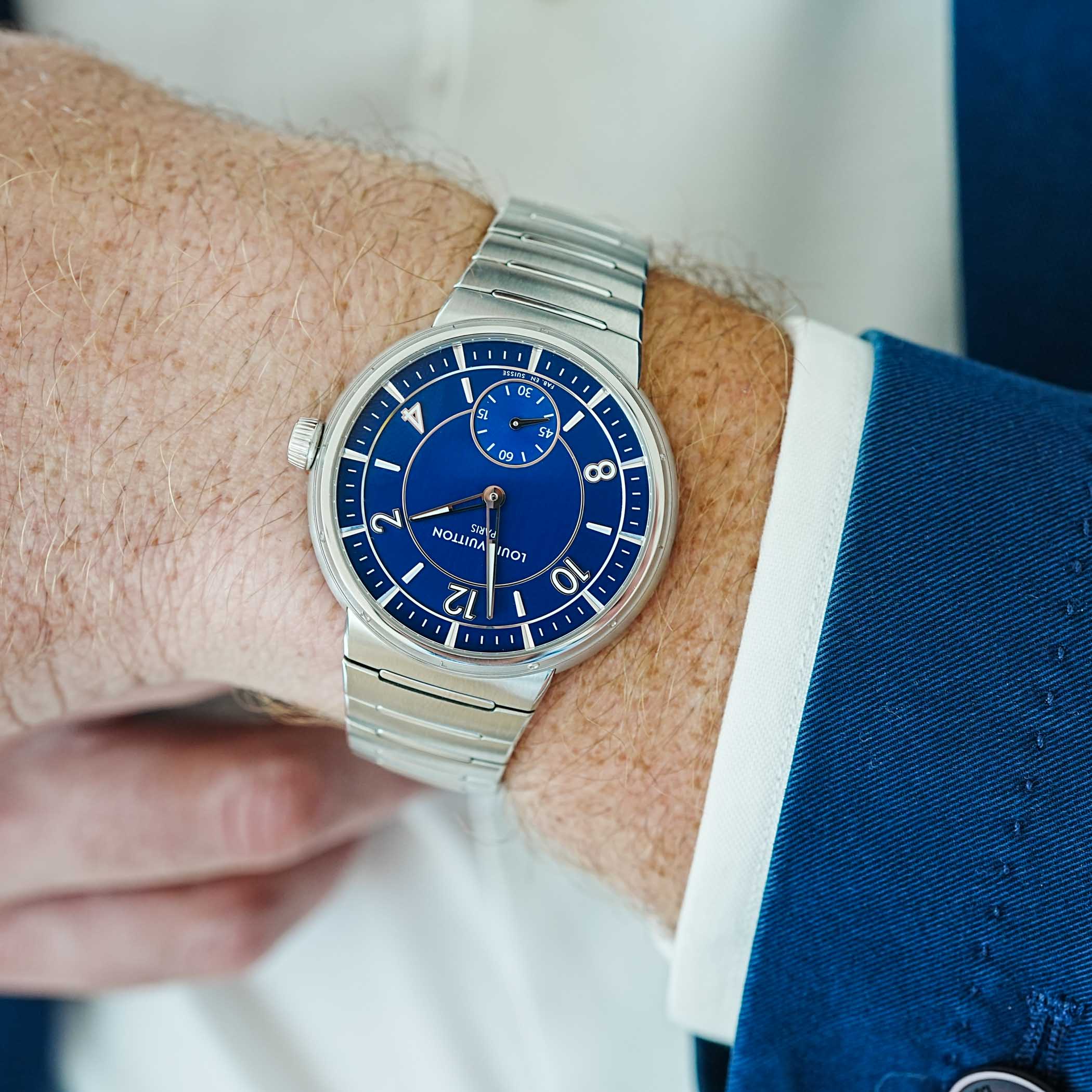
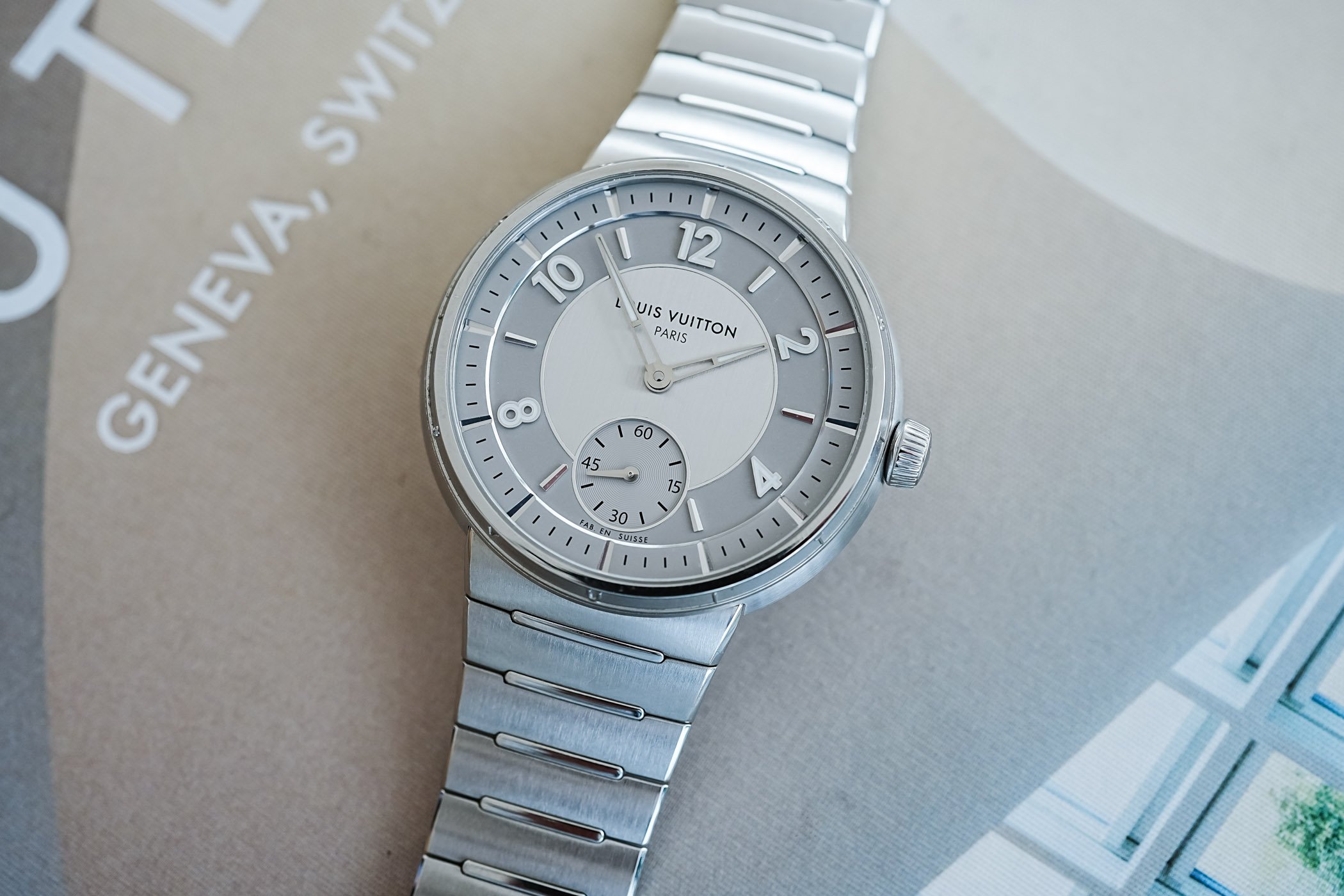
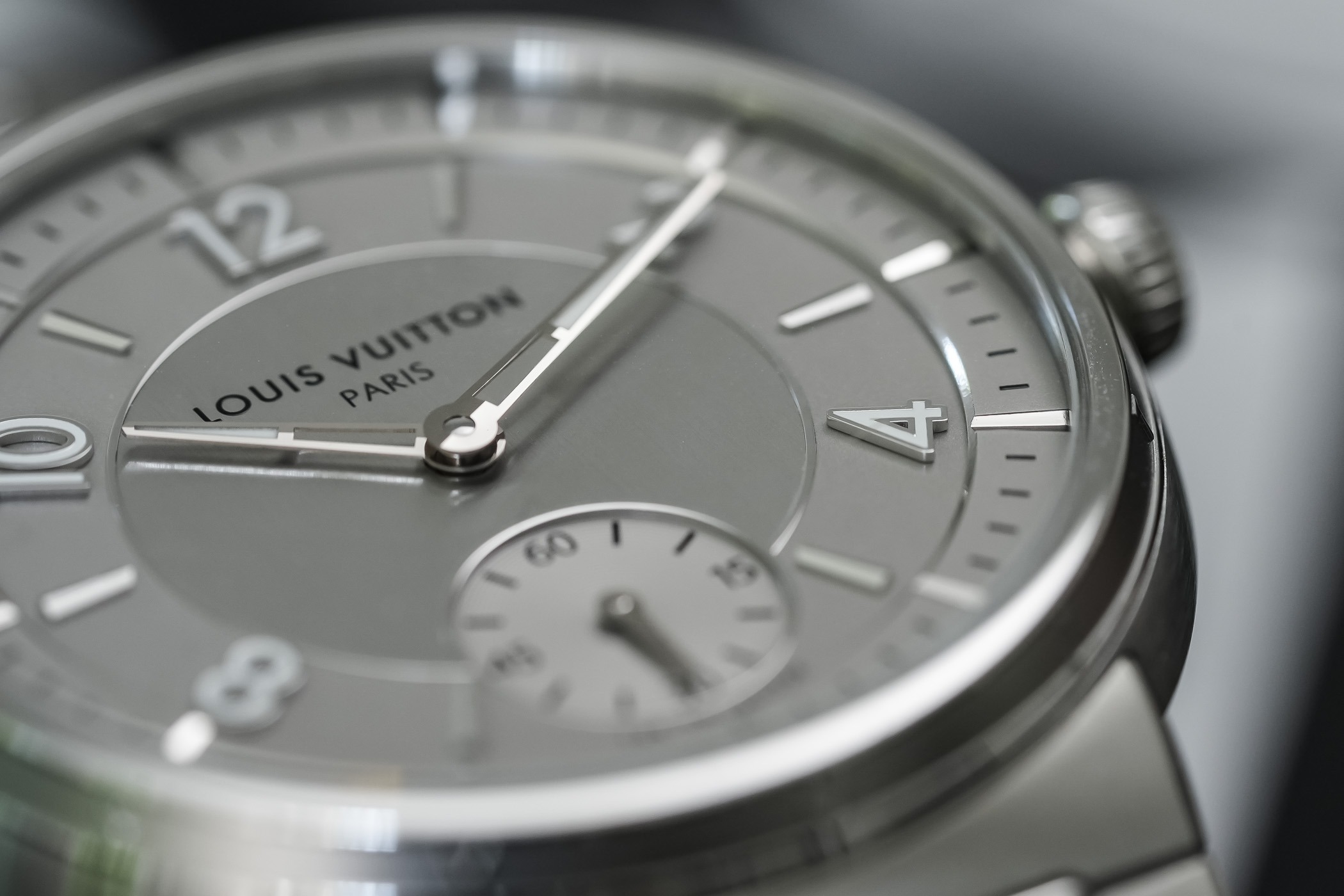
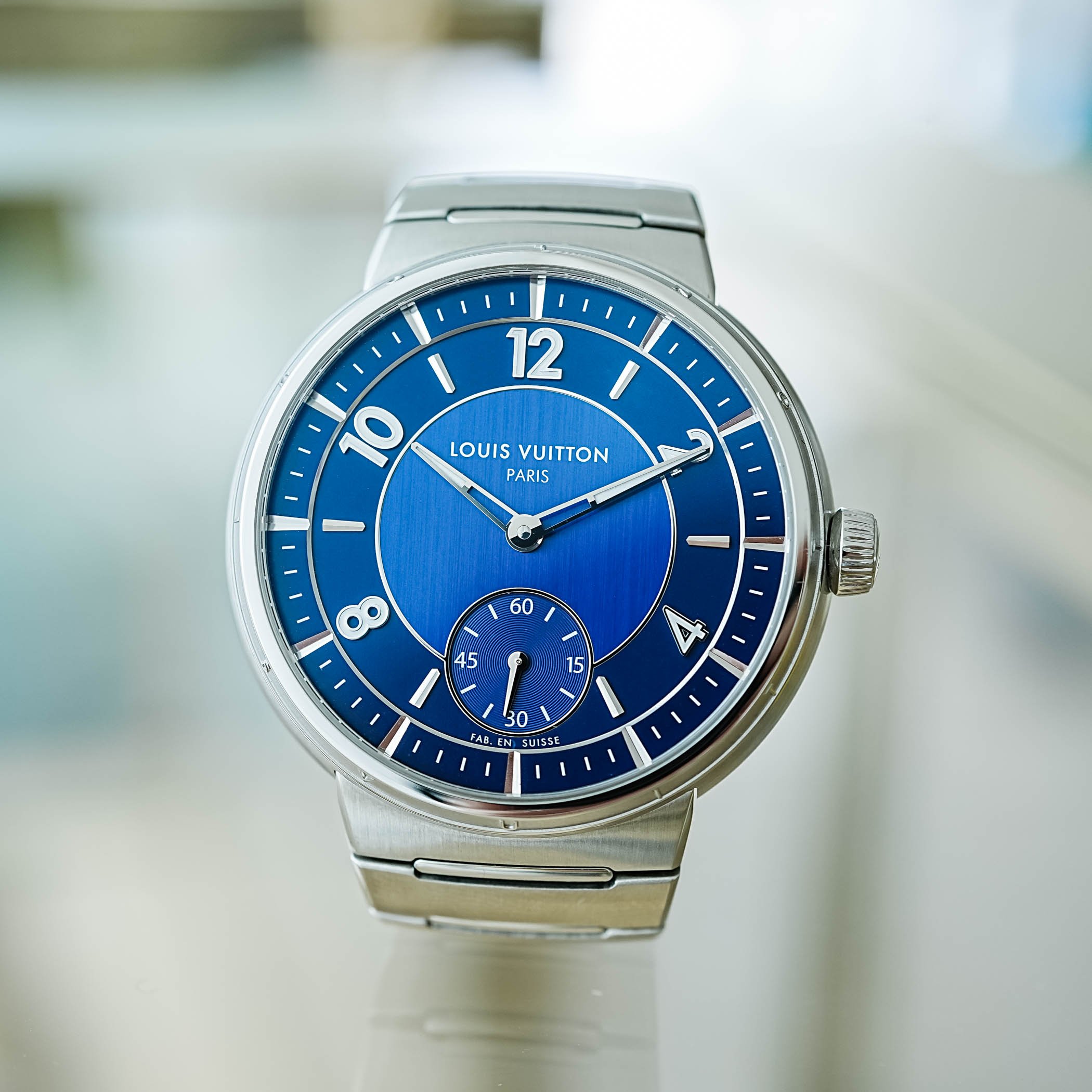
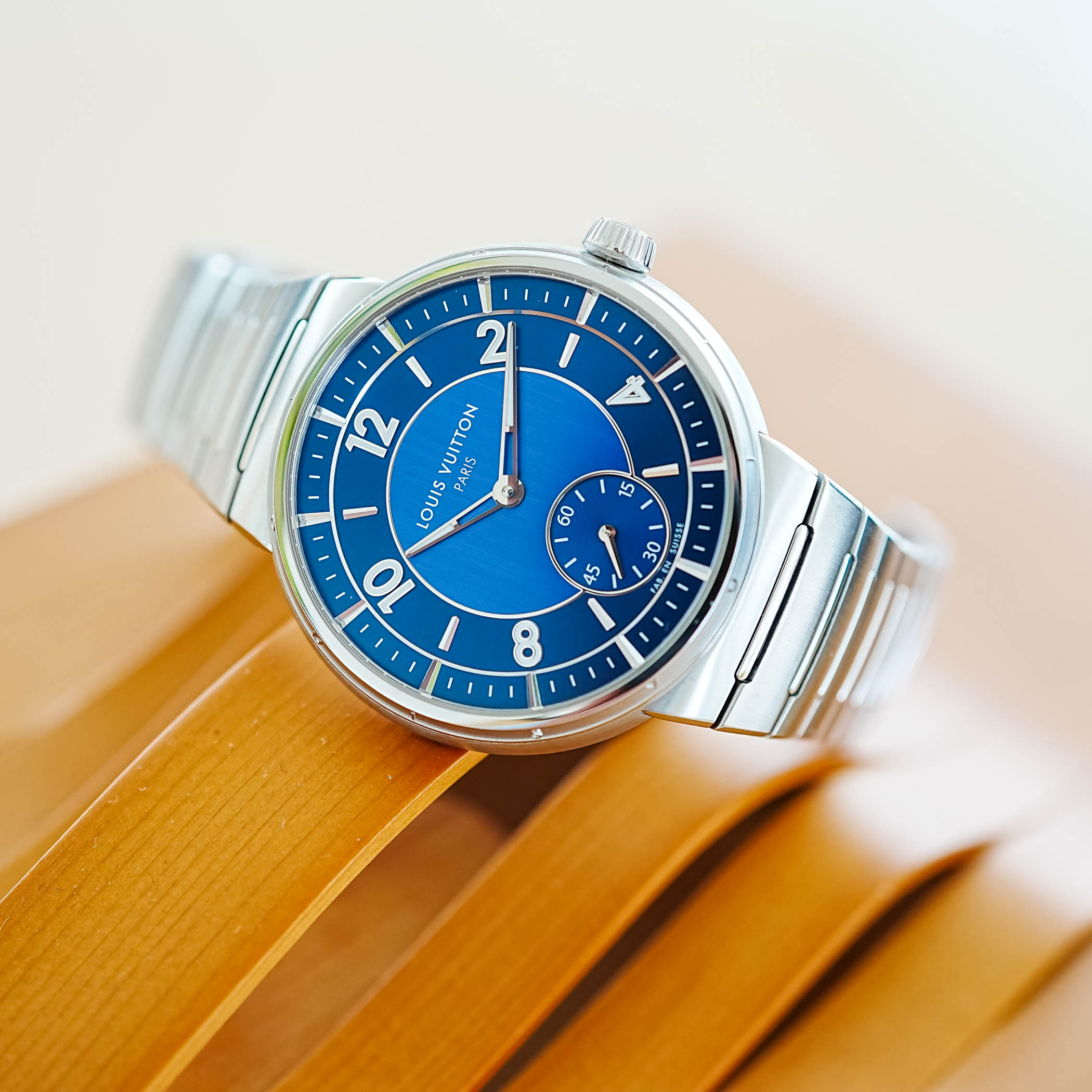
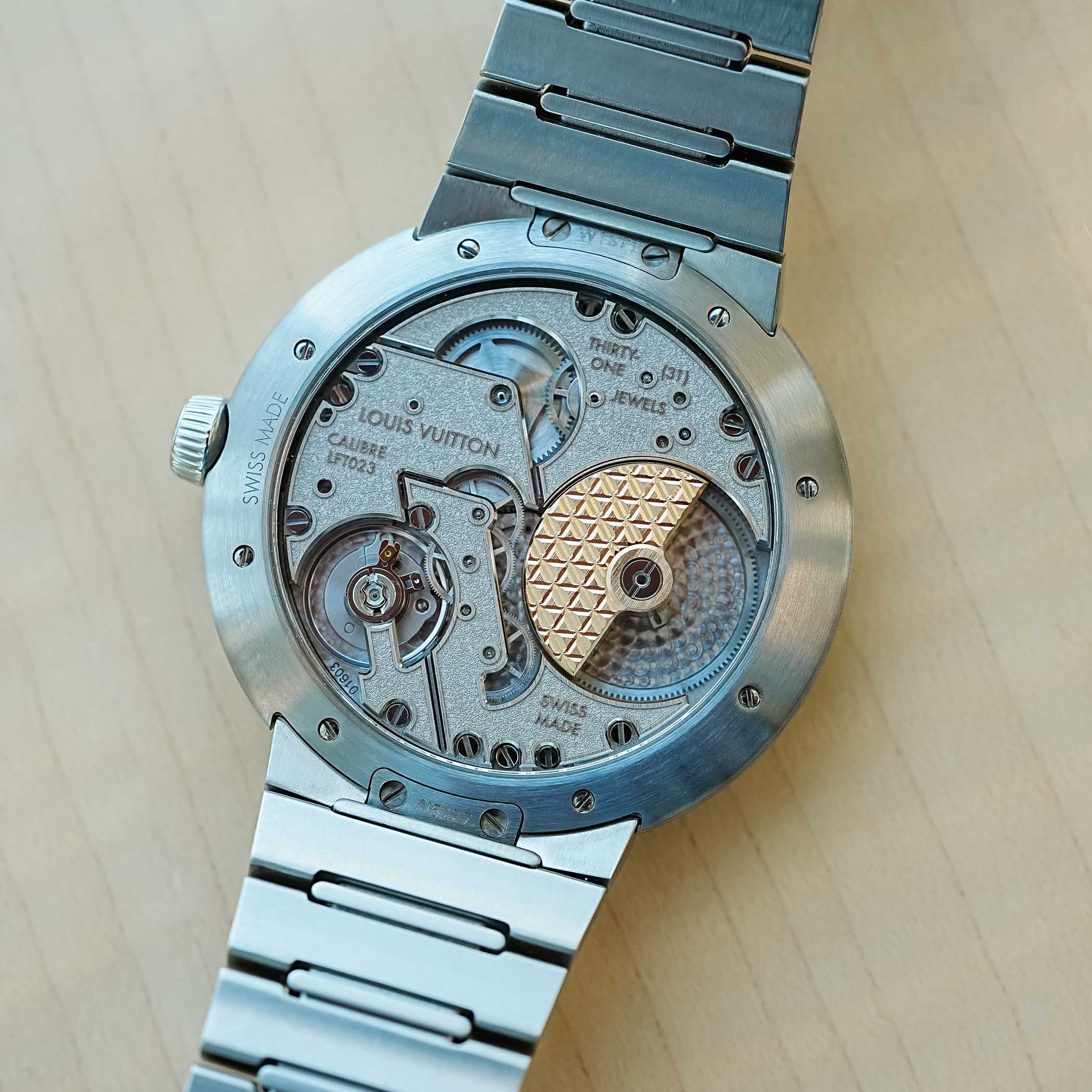
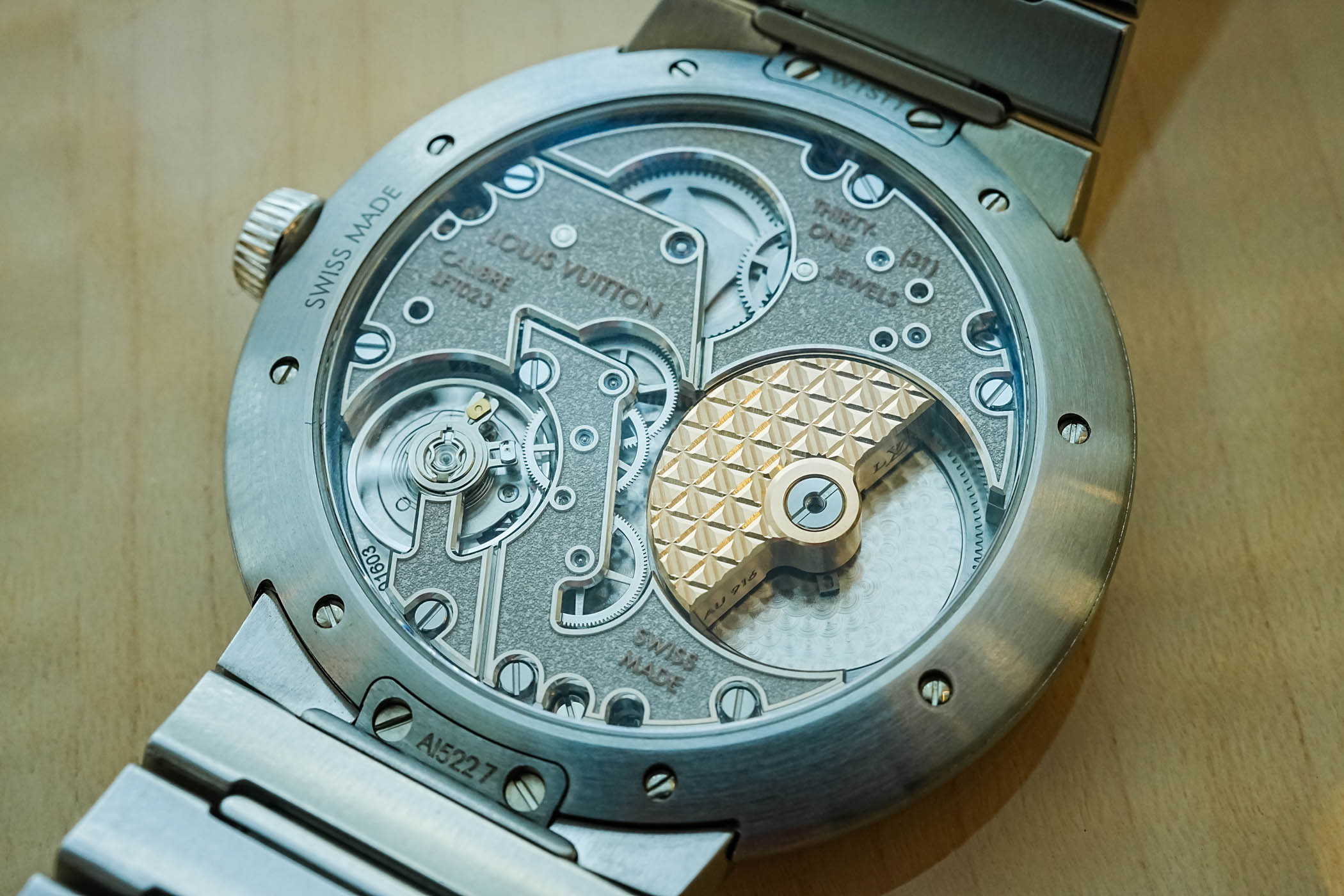




13 responses
I liked this watch, until I saw the price tag.
The micro-rotor is nice, but the movement isn’t pretty at all. At least, it has a chronometer certification.
Looks comfy!
I expected so much worse, having seen the burgers they made before, but 40 x 8.3 – that’s fantastic, well done.
I like the look of the movement as well. Price is high, but possibly fair considering it alongside an AP, maybe?
@R P Why do you like the movement? The sandblasted bridges are ugly and look cheap. I don’t see this watch is related to an AP watch.
I do not think they look cheap, although they certainly could be better, and a simpler architecture would be nice. “Ugly” is not something I can objectively debate.
Having owned a (new!) steel RO with an original AP movement (not the JLC based one), I would rather give this one a shot. Apart from the look, that watch was pants: minute hand leaped when trying to set the time, chronometric performance was abysmal, bracelet pinched hairs… Thoroughly underwhelming, and never again. If I want a recognisable, quality sports watch, I’ll take a Rolex any day and twice on Sunday – they’ve all had fabulous chronometric performance and better comfort 🙂
So, for someone who’s got the money and is a LV fan, I was thinking this is not a bad alternative to something like an AP.
Using sandblasted bridges means no finishing. Movements of most watches at this price range are mostly machine finished, however, as I understand it, machine finishing is more expensive than sandblasting. Regarding AP watches, yes, they aren’t accurate. Unfortunately, this website and other watch websites don’t criticize it for some reason or another. I asked an author of this website why he didn’t criticize the accuracy of very expensive watches such as AP and VC watches, but he didn’t answer my question.
It makes sense that you’re interested in this watch because you’re an LV fan. Do you know of the Chopard Alpine Eagle 41 XPS? It is chronometer certified and bears the Poinçon de Genève. The movement has two barrels with about 65 hours of power reserve. The water resistant is 100 meters. It’s a much better watch than this watch. In my opinion, it’s better than the 5711 and the 3-hand AP Royal Oak. Do you have a 3-hand AP Royal Oak or an AP Royal Oak “Jumbo”?
The micro-sandblasting here reminds me of A.L. Breguet’s grenaillage and Gronefeld, even though it’s not the same thing; I appreciate it as a stylistic choice.
I’m not a LV fan (I don’t even own any of their products) and I’m not interested in this watch at all; I was only trying to make a point that for someone in that position, this looks like an interesting proposition. I am a Hermes fan and like quite a few of their watches.
Chopard’s micro-rotor movement is very nice indeed, I agree and I’ve always liked them.
Regarding AP – I had a run of the mill 15450ST, so not a jumbo; I did not hold onto it for very long – there’s no point in owning a poorly performing mechanical watch.
@Anonymous – ps. that would be more pleasant to use a real name (or an allias) and a real email address (which is invisible) in order to communicate with the rest of the crowd here, this allows others to have interactions, and for you to be notified when having an answer…
I’m going to answer multiple of your comments here. Because it all started with Seiko, and I think you somehow missed our point. First of all, we don’t test the accuracy of watches. Why…? First, most of the time, we simply don’t have the opportunity to do it. When seeing and photographing watches at a launch event or a watch fair, it is simply impossible. It also happens that brand send us early prototypes or even watches without a movement (which I hate). Second, we don’t have the equipment or knowledge. Measuring the accuracy of a watch, in order to get a relevant result, requires skills, time (several positions) and a proper tool (often a Witchi) that we don’t have. We thus don’t include this in our articles, also because from one watch to another (understand different examples of a same model), when there isn’t a so-called certification, results can change.
Now, regarding Seiko… I don’t blame the real accuracy of the watches (because we don’t measure it). I blame the communicated/claimed accuracy range of the watches, which I think on some of the models, is poor. I do believe that Seiko can do much better than what is claimed. In fact, we know that many examples of Seiko watches do perform better than claimed. What I think is a missed opportunity is to claim such wide ranges of accuracy for watches that are on the higher-end side of the market, something that doesn’t give the potential customer reassurance. Many brands simple don’t communicate on this, which, in all fairness, isn’t really a good option either.
And to give an end to my comment, accuracy (without certification) is a very complex topic. Two examples of the same watch can perform very differently, according to many variables – temperature, positions, how it has been adjusted or simply the way it is worn by its owner. If accuracy is an important topic for you (and I certainly don’t blame you for that, I totally understand it) then a certified chronometer is the option you should get.
This was the the comments experience in a good while that I have seen on this site.Thanks to the readers and than you Brice,good honest answers are a breath of fresh air !
Have a great summer and please Brice,( and everyone else) keep saying what you think !
Best comments experience. I need some caffeine.?
@Brice Goulard Thank you for your answer. I don’t see how the name a reader chooses to use may affect the communication unless there are several readers who use the same name and post replies on the same articles, which isn’t the case. Using Anonymous or Moki or Carl or Rosie won’t make a difference. I’m not interested in getting email notifications.
On the topic of accuracy, I said it before that I had no issue with complaining about it. What I don’t think is right is the fact that you do it selectively. What do you think is the accuracy range of most watches whose manufactures don’t specify the accuracy range? There are exceptions, but you don’t have to be a great detective to deduce that the accuracy range must be worse than that of chronometer otherwise most manufacturers will boast about it. The next question is what is the average accuracy range of such watches? According to the information on watch forums, the deviation of about 10 seconds or more per day of luxury watches is quite common. That’s comparable to the -10 to +15 seconds range you complained about. My point is that if you complain about the accuracy range of -10 to 15 seconds of Seiko watches, you should also complain about the lack of specified accuracy ranges of other watches because it’s most likely that the actual accuracy range of such watches will be about -10 to +15 seconds or even worse.
By the way, it’s not only this website; most watch websites seem not to care about the lack of specified accuracy ranges of luxury watches. Luxury watch manufacturers can do better, but why bother when they get away with it while Seiko watches get criticized for being transparent?
I’d like to add that the grey dial version looks super nice, not my kind of watch in total and the price is just off the charts ridiculous ( imo).
Wonder what the street price will be,also the used market will set a very different price for this watch ..?